I remember this game. The stick fighters got me. I also notice how the boomerang sounds exactly like the boomerang in the NES Zelda games.
Kung Fu Review Rewind
|
|
See PixlBit's Review Policies

On 08/11/2020 at 09:00 AM by Jamie Alston Kick, punch, it’s all in the mind. |

There’s enjoyment to be had in short bursts.
On October 18, 1985, the Nintendo Entertainment System was launched in the US. Among the 18 games released alongside it was Kung Fu. A rather unassuming title, Kung Fu has an intriguing history behind it. It started as an arcade game from Irem called Kung-Fu Master and was intended to be based on the movie Game of Death- Bruce Lee’s final film before he died. Later in the course of development, the story and characters were changed to become a tie-in to the Jackie Chan film Spartan X (aka Wheels on Meals). Most noteworthy about the game was its genre-defining gameplay elements that are considered by many to be the first example of what would come to be known as a beat ‘em up.
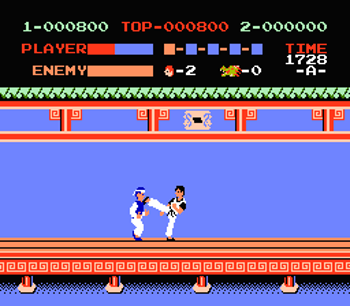
That Kung Fu is inspired by the martial arts movie craze of the 70s and 80s can be seen in the game’s plot. You play as Thomas- a man on a mission to save his girlfriend from the clutches of Mr. X and his goons. You’ll have to fight it out in a five-floor pagoda, and you have 2000 seconds per floor to do it. Thomas is armed with two fists of fury and deadly footwork. With them, he can punch, kick, and perform aerial variations of both attacks. The moves are quite basic by today’s standards, but it worked well enough at the time.
The goal of each stage is to reach the stairs to the next floor. And of course, before you make it to said stairs, you’ll have to get past the boss. Most of them aren’t too difficult to defeat once you learn how to attack while keeping your distance.
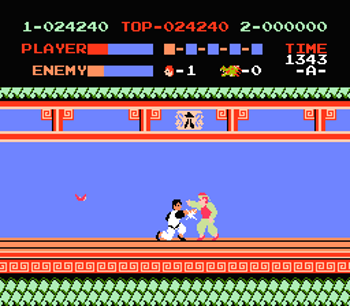
During the first level, you can easily carve a path through the endless parade of henchmen. But as you go further into each level, the attack patterns of some enemies change up a bit. Grippers attack more frequently in bigger groups. The smaller baddies will sometimes surprise you and pull an aerial attack instead of walking into your kicks.
The knife-throwers become especially troublesome when they attempt to evade you after throwing their weapon, often when the boss for that area just walked onscreen. They also have high and low attacks, so you must either jump or crouch, depending on which attack he uses. So you’ll have to decide if it’s worth the trouble to go after him or defeat the boss and get on with things quickly.
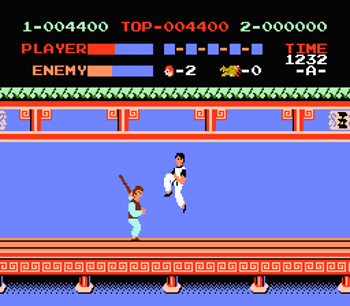
The controls are very responsive as long as Thomas is on the ground. He feels swift when switching directions- a necessity since you’ll have to fend off attacks from both sides. Sometimes his jump kick feels stiff, which causes problems when attempting to dodge a thrown weapon while avoiding contact with other enemies. I rarely bothered with doing a high punch, as they don’t connect as well as a standing or crouching attack. No matter, the game’s mechanics are far from broken. It just could have used a little more polish, perhaps.
While Kung Fu is a fairly decent port of the arcade original, it does have what some these days would consider a shortcoming; it’s a rather brief game with only five stages that loop back to the beginning with a harder difficulty each loop. Once you defeat Mr. X on the top floor, you will have seen all the game has to offer. To be fair, this was commonplace in most video games back then, especially arcade-to-home conversions.
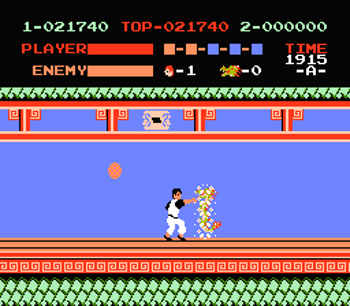
Kung Fu offers a humble visual presentation. The detailed background with windows and support columns found in the arcade original is missing from the console port. Here, the characters are smaller, and the colors are simplified to accommodate the limitations of the NES. Even so, Thomas is well animated with his various moves, and the boss characters look pretty good as well. I’d venture to say that this game had a better visual presentation than other NES launch titles.
The audio quality was a good attempt at emulating the arcade version. What stands out to me the most are the digitized voices. Each time you kick or punch, Thomas makes a realistic quip. The same occurs when bosses sustain damage as well. They also laugh if they defeat you. Kung Fu is a game that most people might have an easier time remembering what it sounded like more so than how it played.
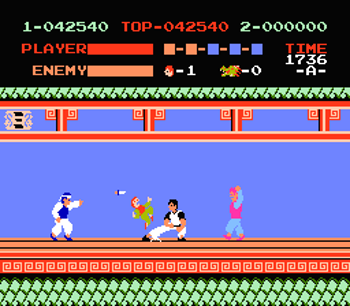
If you played more polished brawlers like Double Dragon, Final Fight, or Streets of Rage, you’ve played remnants of this game in one way or another. Kung Fu introduced the idea of taking on multiple enemies at once, culminating in a fight with a boss character at the end of each level. The player and boss characters’ energy meters and the one-on-one nature of the boss fights would later inspire the core design of the Street Fighter series. The game’s brevity and repetitive nature may keep this from being a must-have for some. Nevertheless, Kung Fu was still a decent foray into a genre that would later see many more games refine the work that started here.







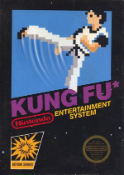


Comments